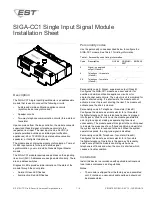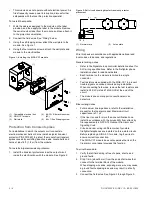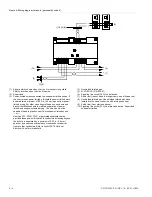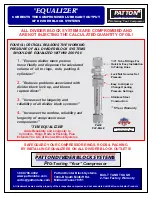
SIGA-CC1 Single Input Signal Module
Installation Sheet
Description
The SIGA-CC1 Single Input Signal Module is an addressable
module that is used to connect the following circuits:
•
Audible and visible notification appliance circuits
(synchronized or unsynchronized)
•
Speaker circuits
•
Two-way telephone communication circuits (three-state or
four-state)
Upon command from the loop controller, the module connects
supervised Class B signal or telephone circuits to the
respective riser input. The riser input can be 24 VDC (to
operate polarized audible and visible signal notification
appliances), 25 or 70 VRMS (to operate audio evacuation
speakers), or firefighter telephones.
The module does not provide signal synchronization. To meet
UL 864 requirements for horn and strobe signal
synchronization, you must install a Genesis Signal Master
module.
The SIGA-CC1 module requires one address on the signaling
line circuit (SLC). Addresses are assigned electronically. There
are no address switches.
Diagnostic LEDs provide visible indication of the state of the
module through the cover plate:
•
Normal: Green LED flashes
•
Alarm/active: Red LED flashes
Personality codes
Use the personality codes described below to configure the
SIGA-CC1 module. See Table 1 for listing information
Table 1: Personality code listing information
Code
Description
UL 864
CAN/ULC-
S527
EN 54-18
5
Signal - supervised
output (Class B)
6
Telephone - three-state
(Class B)
26
Telephone - four-state
(Class B)
Personality code 5:
Signal - supervised output (Class B).
Configures the SIGA-CC1 module as a riser selector for
audible and visible notification appliance circuits or for
single-channel audio circuits. The output circuit is monitored for
open or shorted wiring. If a short exists, the module will not
activate in order to prevent shorting the riser. The module will
activate once the short is cleared.
Personality code 6
: Telephone - three-state (Class B).
Configures the module as a riser selector for a three-state
firefighter telephone. When a telephone handset is plugged
into its jack or lifted from its hook, the module generates its
own ring-tone signal, making a separate ring-tone riser
unnecessary. The module sends this signal to the control panel
to indicate the presence of an off-hook condition, and waits for
the system operator to respond to the call. When the system
operator responds, the ring-tone signal is disabled.
Personality code 26:
Telephone - four-state (Class B).
Configures the module as a riser selector for a four-state
firefighter telephone. Operation is the same as Personality
code 6 except that the module can distinguish when a
telephone is off-hook and when the circuit is shorted, which
causes a trouble condition.
Installation
Install this device in accordance with applicable national and
local codes, ordinances, and regulations.
Notes
•
The module is shipped from the factory as an assembled
unit; it contains no user-serviceable parts and should not
be disassembled.
© 2015 UTC Fire & Security Americas Corporation, Inc.
1 / 6
P/N 387022P-EN • REV 12 • ISS 22JUN15
























